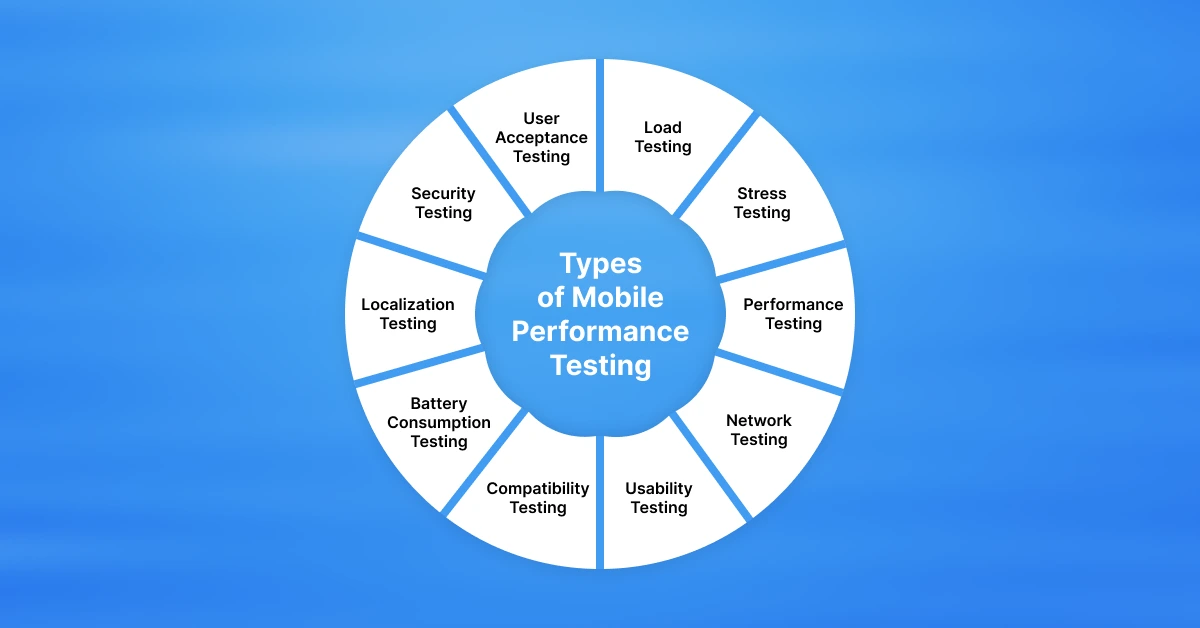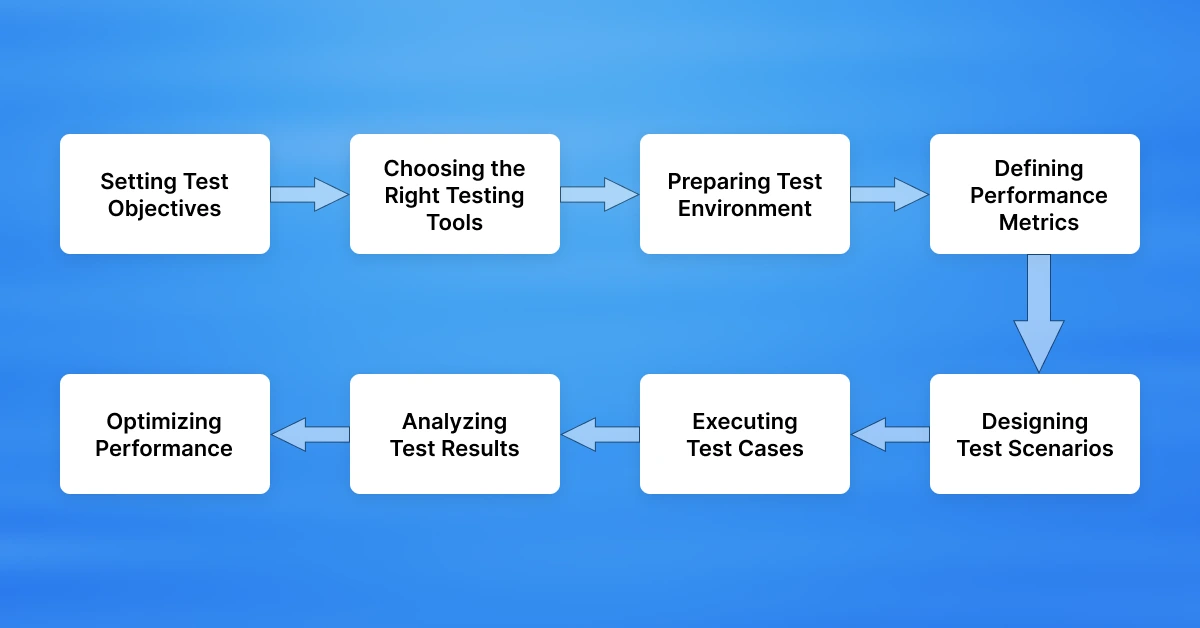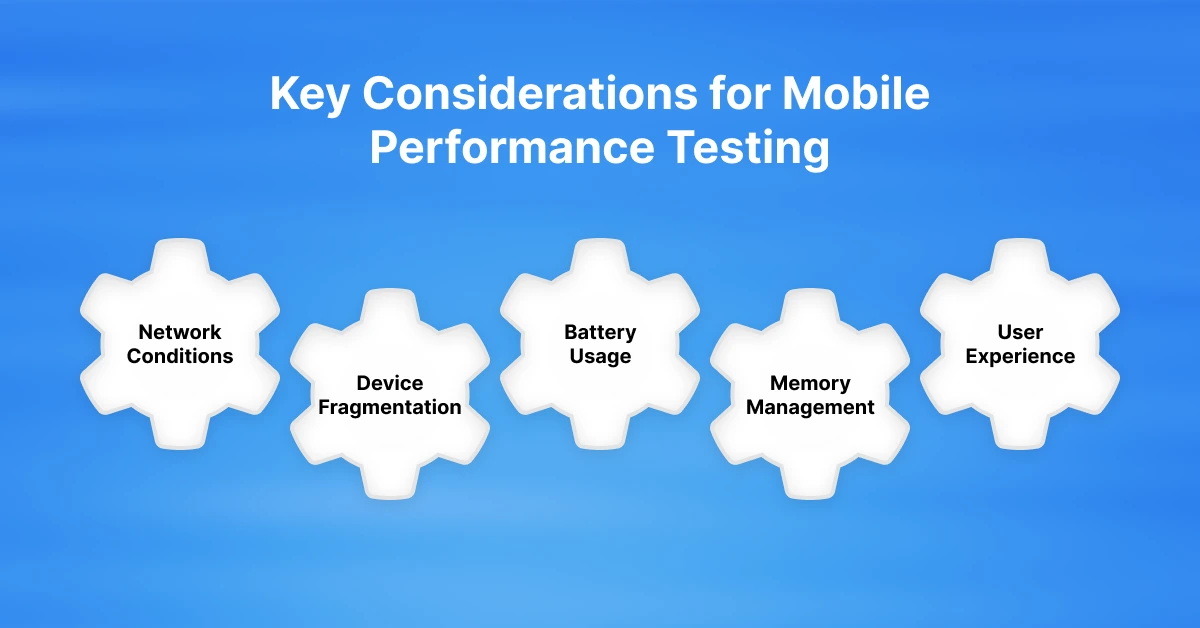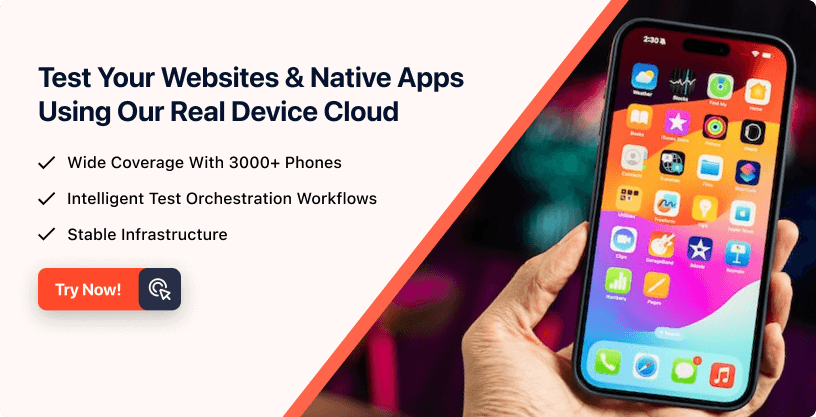- Testing Basics
- Home
- /
- Learning Hub
- /
- Mobile Performance Testing
- -
- July 18 2023
Mobile Performance Testing: A Comprehensive Tutorial
Boost Your Mobile App's Performance! Discover Proven Strategies for Mobile Performance Testing. Increase User Satisfaction & Rankings. Get Results Fast!
OVERVIEW
In today's digital landscape, where mobile devices have become an integral part of our lives, it is crucial for businesses to prioritize the performance of their websites on mobile platforms. Mobile performance testing plays a significant role in ensuring that websites are optimized for seamless functionality, faster loading times, and an overall enhanced user experience.
This article delves into the importance of mobile performance testing and provides valuable insights into improving your website's speed and functionality on mobile devices.
What is Mobile Performance Testing?
Mobile Performance Testing is a crucial process that evaluates the speed, responsiveness, stability, and overall performance of mobile applications. It involves analyzing the app's behavior under various conditions, such as different network strengths, battery levels, and device configurations. By conducting rigorous tests, organizations can identify and rectify performance bottlenecks, ensuring a seamless user experience on mobile devices.
Importance of Mobile Performance Testing
Mobile performance testing is an essential aspect of ensuring a seamless user experience in today's digital landscape. It involves evaluating and measuring the performance characteristics of mobile applications under various conditions, such as different network strengths, varying user loads, and device capabilities. By conducting comprehensive mobile performance testing, organizations can unlock a myriad of benefits that contribute to their success.
Here are some key pointers highlighting the importance of mobile performance testing:
- User Satisfaction: In a world where users have increasingly high expectations, mobile performance testing plays a vital role in delivering a satisfying user experience. By analyzing and optimizing factors like response times, load times, and overall app stability, organizations can provide users with a fast, reliable, and frustration-free mobile experience. Satisfied users are more likely to engage with the application, recommend it to others, and remain loyal to the brand.
- Retention and Revenue: Studies consistently show that poor app performance can lead to user churn and revenue loss. Mobile performance testing enables organizations to identify and address bottlenecks, crashes, or slow loading times that can hinder user retention. By providing a seamless mobile experience, businesses can enhance customer loyalty, encourage repeat usage, and ultimately drive revenue growth.
- Brand Reputation: Mobile applications that consistently perform well build a positive brand reputation. On the other hand, frequent crashes, unresponsiveness, or slow load times can significantly damage a brand's image. Mobile performance testing allows organizations to proactively identify and rectify performance issues before they impact users. By delivering a reliable and high-performing mobile application, businesses can cultivate trust, credibility, and a strong brand identity.
- Device Fragmentation: The mobile ecosystem is highly fragmented, with numerous device models, operating systems, screen sizes, and network conditions. Mobile performance testing enables organizations to ensure their applications work seamlessly across a wide range of devices and configurations. By understanding and optimizing performance for different platforms, businesses can reach a larger audience, expand their user base, and improve market penetration.
- Competitive Advantage: Providing an exceptional mobile experience holds paramount significance as a key distinguishing factor. Mobile performance testing enables enterprises to evaluate the performance of their applications, comparing them against industry benchmarks and competitors. By consistently monitoring and optimizing performance, organizations can maintain a competitive advantage, allure a larger user base, and secure a leading position in the market.
- Scalability and Peak Load Handling: Mobile performance testing helps organizations evaluate their application's ability to handle varying user loads, especially during peak usage periods or promotional events. By simulating heavy user traffic and load conditions, businesses can identify potential bottlenecks, optimize resource allocation, and ensure their application remains responsive and stable under high demand.
- Cost Optimization: Performance issues can have financial implications. Mobile performance testing allows organizations to identify inefficient resource utilization, excessive data consumption, or poorly optimized code that can lead to higher infrastructure costs or increased user data charges. By addressing these issues proactively, businesses can optimize resource allocation, minimize operational expenses, and enhance overall cost efficiency.
Optimizing your mobile app's performance delivers a seamless user experience. Try LambdaTest Now!
Types of Mobile Performance Testing

It is a critical aspect of mobile app development and helps ensure that the app functions optimally, delivers a smooth user experience, and performs efficiently under different scenarios.
There are different types of mobile performance testing that can be conducted to assess various aspects of an application's performance. These types include:
Load Testing
Load testing is a type of mobile performance testing that evaluates how well a mobile application or website performs under normal and peak loads. It simulates real-life scenarios by subjecting the application to a high volume of concurrent user interactions. By measuring response times, resource utilization, and system stability, load testing helps identify bottlenecks and optimize performance for a smooth user experience.
Stress Testing
Stress testing goes beyond load testing by subjecting mobile applications or websites to extreme conditions. It aims to determine the breaking point or the maximum capacity of the system. By pushing the boundaries of the application, stress testing helps uncover vulnerabilities, assess performance degradation, and ensure the system's stability even under stressful conditions.
Performance Testing
Performance testing focuses on evaluating the overall performance of a mobile application or website. It measures response times, resource usage, and system behavior under different loads. By conducting performance testing, developers can identify performance issues, fine-tune the application, and optimize its efficiency, resulting in a seamless and enjoyable user experience.
Network Testing
Mobile applications heavily rely on network connectivity for data exchange and functionality. Network testing assesses the performance and reliability of a mobile application under different network conditions, such as varying bandwidth, latency, and packet loss. By analyzing how an application behaves in different network environments, developers can optimize network usage, minimize data transfer, and enhance the app's responsiveness.
Usability Testing
Usability testing focuses on evaluating how users interact with a mobile application or website. It helps identify user experience issues, such as confusing navigation, unclear instructions, or unresponsive elements. By conducting usability testing, developers can make necessary adjustments to improve the overall usability and ensure that users can easily navigate through the application, leading to increased engagement and satisfaction.
Compatibility Testing
Compatibility testing ensures that a mobile application or website functions correctly across different devices, operating systems, and screen sizes. It aims to identify any compatibility issues that may arise due to variations in hardware, software, or configurations. By conducting compatibility testing, developers can make necessary adjustments to ensure a consistent experience across various mobile platforms, thus widening the reach and accessibility of their applications.
Battery Consumption Testing
Mobile devices are powered by batteries, and optimizing battery consumption is essential for providing a positive user experience. Battery consumption testing measures the impact of an application on a device's battery life. By identifying energy-hungry components or inefficient processes, developers can optimize the application's energy usage and extend the device's battery life, resulting in improved user satisfaction and longer engagement.
Localization Testing
Localization testing ensures that a mobile application or website is adapted to different languages, cultures, and regions. It involves checking language translations, date and time formats, currency symbols, and other locale-specific elements. By conducting localization testing, developers can ensure that their applications are culturally appropriate and provide a seamless experience to users worldwide.
Security Testing
Security is a critical aspect of mobile applications, considering the sensitive data they often handle. Security testing aims to identify vulnerabilities, loopholes, or potential threats that could compromise the privacy and integrity of user data. By conducting security testing, developers can implement robust security measures, encrypt sensitive information, and protect against potential cyberattacks, fostering trust and confidence among users.
User Acceptance Testing
User acceptance testing involves real users testing a mobile application or website to ensure it meets their expectations and requirements. It helps gather feedback, uncover usability issues, and validate the application's overall performance and functionality. By involving users in the testing process, developers can make informed improvements and deliver a user-centric application that fulfills user needs and preferences.
Note : Automate your Front end tests across 3000+ browser environments. Try LambdaTest Now!
Steps to Conduct Mobile Performance Testing

Setting Test Objectives
Before diving into Mobile Performance Testing, it is essential to define clear objectives. This involves identifying the performance goals, such as response time, throughput, and resource utilization. Additionally, it is crucial to determine the target audience and expected usage patterns to simulate real-world scenarios accurately.
Choosing the Right Testing Tools
Selecting the appropriate testing tools is crucial for effective Mobile Performance Testing. Various tools are available in the market, offering features specifically designed for mobile application testing. Some popular options include Apache JMeter, LoadRunner, Gatling, Appium, and Firebase Test Lab. Evaluate the requirements and choose the tool that best suits your needs.
Boost your productivity and ensure flawless user experiences. Try LambdaTest Now!
Preparing Test Environment
Creating a realistic test environment that closely simulates the production environment is essential for accurate results. This includes configuring network conditions, emulating different devices with varying screen sizes and hardware specifications, and considering factors like battery usage and memory constraints.
The test environment should represent the diversity of devices and network conditions your target audience may encounter. This ensures that your mobile application performs optimally under different scenarios.
Test Real world scenarios on a real device cloud for Experience the ultimate testing environment Try LambdaTest Now!
Defining Performance Metrics
Defining relevant performance metrics is necessary to measure the application's performance accurately. Key metrics include response time, CPU and memory usage, network latency, battery consumption, and user interface responsiveness.
By establishing clear performance metrics, you can set benchmarks, track improvements, and identify areas where optimization is required. This data will help you make informed decisions regarding the application's performance.
Designing Test Scenarios
Test scenarios represent real-world user interactions with the application. They should cover various use cases, simulate different network conditions, and include stress and load testing to evaluate performance under peak loads.
Consider the different functionalities of your mobile application and design test scenarios that cover all critical aspects. These scenarios should mimic actual user interactions, including navigating through screens, inputting data, and performing actions.
Executing Test Cases
Once the test scenarios are defined, it's time to execute the test cases on selected devices and monitor performance. Collect relevant metrics and logs to analyze the application's behavior under different scenarios.
During test execution, it is important to capture performance data and metrics accurately. This data will be used for analysis and optimization in the subsequent steps.
Experience the power of HyperExecute for a staggering 70% reduction in test execution time Try LambdaTest Now!
Analyzing Test Results
After executing the test cases, it's crucial to analyze the collected data to identify performance bottlenecks and areas for improvement. This analysis helps in understanding the application's behavior under different scenarios and identifying potential issues affecting performance.
Pinpointing performance issues requires a combination of quantitative and qualitative analysis. Look for patterns and anomalies in the data, identify the root causes of performance bottlenecks, and prioritize areas for optimization.
Optimizing Performance
Based on the analysis of test results, make necessary optimizations to enhance the application's performance. This could involve code optimizations, database tuning, caching strategies, network optimizations, or other performance-enhancing techniques.
Optimization is an iterative process that involves implementing changes, retesting, and validating the impact on performance. Continuously monitor the application's performance after each optimization to ensure the desired improvements are achieved.
Key Considerations for Mobile Performance Testing

Mobile Performance Testing comes with its unique set of considerations. By addressing these considerations, you can ensure comprehensive testing and optimal performance of your mobile application. Here are some key considerations:
Network Conditions
Mobile applications operate in diverse network conditions, including 3G, 4G, and varying signal strengths. It is crucial to test the application's performance across different network conditions to ensure consistent performance. Consider simulating real-world network scenarios, such as low bandwidth or intermittent connectivity, to assess the application's behavior in challenging network environments.
Device Fragmentation
The Android ecosystem has a wide variety of devices with different screen sizes, resolutions, processing power, and memory capacities. Testing on multiple devices helps identify compatibility issues and performance variations. Ensure that your Mobile Performance Testing strategy includes a diverse range of devices to validate the application's performance across various hardware configurations.
Battery Usage
Mobile applications that drain the device's battery quickly can result in poor user experiences. Testing the application's battery consumption and optimizing power usage is essential for enhancing performance and user satisfaction. Monitor the application's power consumption during different scenarios, such as idle, active usage, and background processes, to identify any abnormal battery drain.
Memory Management
Mobile devices typically have limited memory resources compared to desktop computers. Testing the application's memory usage and implementing efficient memory management techniques can prevent crashes and improve overall performance. Monitor the application's memory footprint during different usage scenarios and optimize memory usage to ensure smooth and stable performance.
User Experience
Mobile Performance Testing should also consider the user experience aspects of the application. Factors such as loading times, UI responsiveness, smooth navigation, and overall usability contribute to a positive user experience. Assess the application's performance from the user's perspective and ensure that it meets the expectations of a seamless and enjoyable mobile experience.
Best Practices for Mobile Performance Testing

To ensure effective Mobile Performance Testing, it is important to follow industry best practices. These practices will help you optimize your testing efforts and achieve accurate and actionable results. Here are some best practices to consider:
Test Early and Test Often
Start testing as early as possible in the development cycle and continue throughout the application's lifecycle. Early testing helps identify performance issues in the early stages of development, allowing for prompt resolution. Regular testing at different stages ensures that performance improvements are continuously made and any regressions are caught early.
Simulate Real User Scenarios
Design test scenarios that closely mimic real-world user interactions and usage patterns. Consider factors like network fluctuations, simultaneous background processes, intermittent connectivity, and various device configurations. By simulating realistic scenarios, you can assess how the application performs under typical user conditions.
Monitor Performance in Real-time
Monitoring the application's performance in real-time testing provides valuable insights into its behavior under different scenarios. Real-time monitoring allows you to capture performance data, identify anomalies, and make immediate adjustments if required. It also enables you to collect data for analysis and optimization after the testing phase.
Embrace Automation
Automation tools can streamline the Mobile Performance Testing process by executing repetitive tasks, simulating user interactions, and generating detailed reports. Leveraging automation helps save time, improves efficiency, and ensures consistent and repeatable test results. Choose an automation framework or tool that aligns with your requirements and provides support for Mobile Performance Testing.
Note : Streamline your automation testing with our cloud-based solution. Try LambdaTest Now!
Continuously Optimize Performance
Mobile applications are constantly evolving, with new features, updates, and user demands. Regularly monitor and optimize performance even after the initial release. Gather feedback from users, monitor performance metrics, and leverage performance monitoring tools to proactively identify areas for improvement. Implementing continuous optimization practices ensures that your application delivers optimal performance throughout its lifecycle.
Tools for Mobile Performance Testing
Several tools are available in the market to assist you in conducting Mobile Performance Testing. These tools provide features and capabilities specifically designed for mobile application testing. Here are some popular tools:
LT Browser
LT Browser stands out as an exceptional web testing tool, empowering developers and designers to craft responsive websites effortlessly. Its intuitive interface and comprehensive functionality make website testing on multiple devices a breeze. By delivering precise visual rendering across diverse screen sizes, facilitating time-efficient multi-device testing, and enabling swift issue detection, LT Browser boosts overall website performance.
Apache JMeter
Apache JMeter is an open-source tool widely used for performance testing, including mobile applications. It offers features like load testing, stress testing, and performance analysis. With its extensible architecture and large user community, Apache JMeter provides flexibility and scalability for Mobile Performance Testing.
LoadRunner
LoadRunner is a popular commercial performance testing tool that supports mobile application testing. It provides a comprehensive set of features for load testing, stress testing, and performance monitoring. LoadRunner offers robust scripting capabilities and integrates with various mobile devices and platforms for accurate and realistic testing.
Gatling
Gatling is an open-source load testing tool that can be used for Mobile Performance Testing. It is known for its scalability and real-time analytics capabilities. Gatling allows you to simulate thousands of virtual users and monitor performance metrics in real-time, enabling effective load testing and performance analysis for mobile applications.
Appium
Appium is an open-source automation framework specifically designed for mobile applications. It supports both iOS and Android platforms, allowing you to write tests using popular programming languages such as Java, Python, or JavaScript. Appium provides a unified API for cross-platform testing, making it a versatile tool for Mobile Performance Testing.
Firebase Test Lab
Firebase Test Lab is a cloud-based testing platform provided by Google. It offers a range of testing capabilities for mobile applications, including performance testing on real devices and virtual devices. With Firebase Test Lab, you can perform automated testing, monitor performance metrics, and access a wide range of devices for comprehensive Mobile Performance Testing.
Challenges in Mobile Performance Testing
Mobile Performance Testing comes with its own set of challenges that testers need to address to ensure accurate and effective testing. Understanding these challenges helps in devising appropriate strategies and solutions. Here are some common challenges in Mobile Performance Testing:
Network Variability
Mobile applications are often used in different network conditions, ranging from high-speed Wi-Fi to slow and unreliable cellular networks. Testing the application's performance across different network conditions can be challenging but essential for providing a consistent user experience.
Limited Resources
Mobile devices have limited processing power, memory, and battery life compared to desktop computers. Ensuring optimal performance within these resource constraints requires careful testing and optimization. Testers need to consider resource-intensive scenarios, such as heavy data processing, graphics rendering, or multitasking, and analyze the application's performance under such conditions. Identifying resource bottlenecks and optimizing resource usage is critical for delivering high-performance mobile applications.
Building or Maintaining A Device Farm
The fragmentation of mobile devices with different operating systems, screen sizes, and hardware specifications adds complexity to Mobile Performance Testing. It is important to test on a variety of devices to ensure compatibility and performance consistency.
Testers should create a device matrix that includes a representative sample of devices from different manufacturers, screen sizes, and operating systems to cover a wide range of user scenarios.
Performance Over Different Networks
Mobile applications may need to perform well across different networks, including 3G, 4G, and even low-bandwidth connections. Testing the application's performance under various network conditions helps identify potential issues and optimize performance.
Testers should simulate real-world network conditions, such as slow network speeds or intermittent connectivity, to assess the application's behavior and performance under challenging network scenarios.
Note : If you're a beginner aiming to familiarize yourself with frequently asked performance testing interview questions explore our comprehensive guide for better understanding.
Conclusion
Ensuring an exceptional user experience is paramount for mobile applications, making Mobile Performance Testing a critical component. To achieve the best outcomes, it is crucial to harness the capabilities of LambdaTest. By integrating LambdaTest, you can streamline testing across a wide range of devices, browsers, and operating systems, effectively eliminating compatibility issues. The real device cloud offered by LambdaTest empowers developers to evaluate performance under diverse conditions, yielding invaluable insights for optimization.
Additionally, the LT Browser tool in LambdaTest enables developers to preview and test applications on multiple devices, ensuring consistent visual appeal and functionality. Incorporating LambdaTest in mobile performance testing not only facilitates efficient testing but also provides comprehensive insights, ultimately leading to the delivery of exceptional user experiences in today's ever-evolving mobile landscape.
On this page
- Overview
- What is Mobile Performance Testing?
- Importance of Mobile Performance Testing
- Types of Mobile Performance Testing
- Steps to Conduct Mobile Performance Testing
- Key Considerations for Mobile Performance Testing
- Best Practices for Mobile Performance Testing
- Tools for Mobile Performance Testing
- Challenges in Mobile Performance Testing
- Frequently Asked Questions
Frequently asked questions
- General
Author's Profile

Swapnil Biswas
Swapnil Biswas is a Marketing Specialist at LambdaTest, a tech enthusiast, and a passionate writer with deep expertise in Search Engine Optimization. Known for his innovative marketing strategies, Swapnil's prowess has earned him a place on the Wall of Fame for marketing. His unwavering dedication to professional growth and his enthusiasm for technology mark him as a standout professional in the marketing industry.
Reviewer's Profile

Harshit Paul
Harshit is currently the Director of Product Marketing at LambdaTest. His professional experience spans over 7 years, with more than 5 years of experience with LambdaTest as a product specialist and 2 years at Wipro Technologies as a certified Salesforce developer. During his career, he has been actively contributing blogs, webinars as a subject expert around Selenium, browser compatibility, automation testing, DevOps, continuous testing, and more.
Did you find this page helpful?
More Hubs
Try LambdaTest Now !!
Get 100 minutes of automation test minutes FREE!!

 Christmas Deal is on: Save 25% off on select annual plans for 1st year.
Christmas Deal is on: Save 25% off on select annual plans for 1st year.








